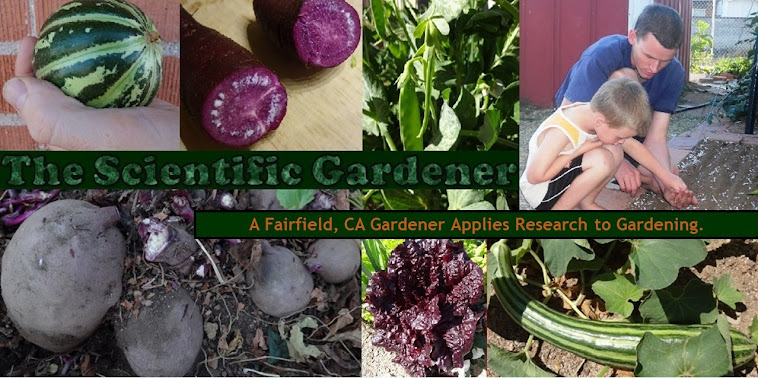In writing this book review I
wish to warn readers that this heavy duty in-depth seed cultivation guide is
not for the faint of heart. However, if you are truly serious about producing
high quality vegetable seed, this is the book for you. The Organic Seed Grower
is a straightforward guide for those who want to learn to prepare vegetables
for winter storage and for those who are seeking to understand the nuances and
methods of vegetable seed selection. This book is devoted more to seed
selection and maintaining the integrity of existing varieties than to breeding new vegetable varieties.
Additional sections in this book elaborate on characteristics of biennial seed crops, maintenance of varietal integrity, adequate population size, seed crop climates, seed borne diseases and seed stock basics.
Here are some thoughts I have had since reading this book:
| The Organic Seed Grower should be shared with the world (= |
As The Organic Seed Grower describes cultivating each vegetable variety, it provides the common name of each variety and includes information on topics such as the crop species, life cycle, mating system,
pollination mode, ideal temperature for pollination and seed formation, reproductive
cycle, row spacing, the isolation
distance required between cultivars of the crop and other crops/plants that will cross with.
Each chapter also
details the reproductive biology, the life cycle of the crop in the field, the
harvest of seeds, the climatic and geographic requirements, growing of the seed
crop including the various growing methods that can be used and the
characteristics that can be selected for to maintain and improve the genetic
stock of the variety.
| Healthy carrot foliage leads to healthy carrot roots |
Additional sections in this book elaborate on characteristics of biennial seed crops, maintenance of varietal integrity, adequate population size, seed crop climates, seed borne diseases and seed stock basics.
I especially enjoyed
reading the sections on melons, carrots, beets, radishes and cucumbers. There
is a chapter that includes Asian greens, but there is no chapter about
artichokes.
One thing I found
interesting in my reading was comparing the differences between carrots and
radishes. I found it fascinating that the section on carrots tells how carrots
can be selected for forking, shoulder type, cracking, root growth patterns and
taste – while radishes can only be selected for root size, shape, color, leaf
size, shape and seedling vigor. Perhaps the major problem we have with many of
the radish varieties out there is that they are not being selected by taste!
| Will we ever find a truly good tasting radish? |
While reading The Organic Seed Grower I learned some new terms that I put into my own words.
Here are six of the new words I am working to incorporate into my gardening
vocabulary:
Cutting a cheek: You
can cut off a cheek, or side, of a beet or other root crop to determine root
color.
Stecklings: Roots
that are stored to produce a seed crop.
By storing, or at
least pulling carrot, beets, or other roots out to look at their skin, growth
habits, color and taste the gardener can better control the genetic traits of
his seed. When using this method, the majority of the vegetative growth (leaves
and stems) down to the apical bud are removed to keep the root from transpiring
water out of wilting leaves. The carrot (root) itself can then be evaluated and
stored over the winter or culled (see below) for specific traits. The remaining
carrots can be replanted in the ground even after taste has been determined by
cutting and eating the bottom of each carrot.
Genetic Drift: The
degree of deviance a population of a specific vegetable variety can experience
if routine selection and culling of rouge or undesirable plants takes place.
Cull: To pull out or
eliminate plants from a population because of a specific undesirable genetic
trait or inferior quality.
Rogue: (verb) To
remove inferior or defective plants or seedlings from a crop. This term loosely
relates to the rogue plants that are being removed.
Lodging: Lodging
refers to the tendency of a stem of a plant falling over. Lodging is an
undesirable characteristic because when a plant falls over it can make the
harvest unmarketable, if not unusable.
| As a strong inbreeder, peas require minimal space to maintain |
Here are some thoughts I have had since reading this book:
As with any good
book, The Organic Seed Grower left me with almost as many questions and
thoughts as it provided answers. For example, “could cutting a cheek possibly
be done with other vegetable crops, such as spring radishes, to improve taste?”
Also, “Using the steckling approach could a farmer use a brix meter to select a sweeter carrot variety?
Another thought I had
was that cutting a cheek would not be the best method for determining carrot
color because the skin of a carrot can exhibit a very different color than its
core. Breeders that are selecting for carrot color would have a lot of work to
do in preparing stecklings and tasting the carrots to determine the optimal
carrot flavor, texture, and color.
| My new found knowledge will definitely aid in my selection of better carrot varieties. |

No comments:
Post a Comment
Dear Gardening Friends,
I look forward to learning more about gardening with you. Your comments help me recognize that gardening is a life-long journey.
To advertisers: Note that this blog is concerned with gardening and gardening techniques. Please do not attempt to advertise here by leaving a comment. Depending upon how egregious the comment is, it may be deleted.